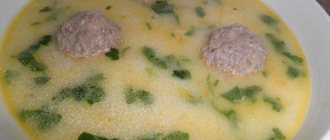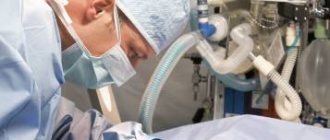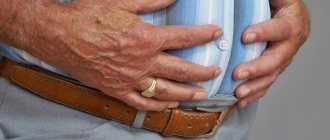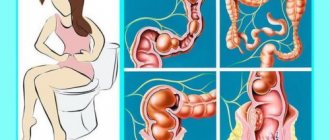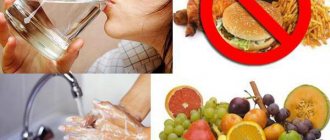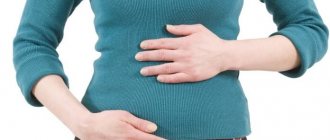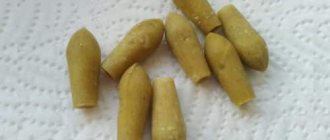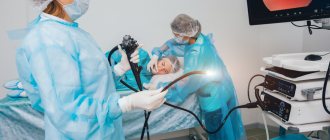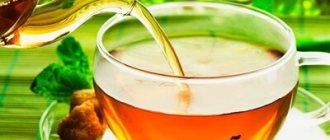Medical nutrition after removal of the stomach for cancer is prescribed to all patients. The diet is based on fractional consumption of food. Doctors recommend eating small portions at least 5 times a day. Patients should have 3 full meals and 2 snacks. The menu is set by a doctor, and people just have to follow all his recommendations.
Nutritional Features
In the first days
After gastric surgery, people are unable to eat or drink, so they are given the required nutritional components intravenously. The need for nutrients is determined individually after receiving blood test results. Gastrectomy is followed by 2 days of fasting. The patient undergoes aspiration of the stomach contents. If the doctor does not detect stagnant processes in the operated organ, then on the 3rd day after removal of part of the stomach the person is allowed to give weak tea, rosehip infusion or compote with a little added sugar. Drinks are consumed in a volume of 30 ml about 6 times.
Eating with a removed stomach involves a gradually increasing load on the digestive system. On day 4, it is permissible to add viscous soups, blended meat, low-fat cottage cheese, and soft-boiled eggs to the menu. After 6 days, the menu is diluted with scrambled eggs, grated cereals and vegetable puree. In the first week, the diet after removal of the stomach suggests a serving size of 50 grams. Then the volume of food is gradually increased.
Return to contents
Further period
7-8 days after the gastrectomy was performed, patients are prescribed a gentle diet, which will need to be followed for 4 months. When the patient's condition is complicated by inflammation or other postoperative consequences, the diet is extended. If a person eats right and follows all the doctor’s recommendations, it will be possible to reduce the inflammatory process and reduce the risk of developing dumping syndrome.
During this period, you should not eat semolina porridge.
The menu at this moment is based on a large amount of protein foods, a moderate amount of slow carbohydrates and a sufficient amount of fat. Fast carbohydrates, for example, sweets, should be excluded from the diet. In addition, nutrition involves avoiding foods that contain flavorings, preservatives and dyes. It is not recommended to eat semolina porridge and fatty soups. The basis of the diet is mashed potatoes, ground meat products, and viscous porridge. Fresh vegetables and fruits are prohibited. A person will have to completely eliminate frying food. It is important to prepare dishes using a steamer or boiling.
Return to contents
Basic recommendations
It is worth noting that not only after surgery you should switch to proper nutrition. This should be taken care of much earlier. The diet should be followed before surgery, this will help prepare the body for the upcoming stress. A few days before gastrectomy, it is recommended to exclude protein foods, as well as foods containing fiber.
Alcohol, carbonated drinks, store-bought juices - all this is prohibited. The menu should include carbohydrates. Preference should be given to complex rather than light carbohydrates. Confectionery products contain simple carbohydrates, which are quickly digested and provoke a sharp jump in blood glucose.
Complex carbohydrates are not digested so quickly, do not cause glycemic changes and bring great benefits to the body. Porridge is a source of complex carbohydrates. Salt, pepper and other spices are completely excluded from the diet.
Now let's talk in more detail about nutrition after gastric surgery for oncology. Immediately after resection and for the next two days, the patient fasts. Only on the third day can the doctor allow rosehip decoction, sweet tea or compote. But this does not mean that the patient can drink in one gulp; every fifteen minutes he is given only one teaspoon of liquid.
Still, the patient’s body needs nutrients, so special mixtures containing proteins and amino acids are injected intravenously. Around the fifth day, the doctor can begin to transfer the patient to a regular diet. But this is subject to the absence of bloating and normal intestinal motility.
And again, this does not mean that the patient can eat whatever he wants: borscht, dumplings, jellied meat, etc. The diet after gastric surgery includes strict restrictions that are extremely important to adhere to.
Nutrition after gastrectomy should include liquid or semi-liquid foods
Even a month after surgery, you must continue to follow the diet. Of course, if the patient feels well, then it is not necessary to consume grated products. The menu at this stage becomes more varied.
Meat soups, lean fish, and slightly dried white bread are allowed. You are also allowed to eat boiled vegetables, fresh fruits, buckwheat and rice porridge, and fermented milk products. After surgery, the elimination of toxic substances slows down, which is why it is so important to consume natural water in sufficient quantities.
You need to prepare for the fact that the first two weeks after surgery are the most difficult. During this period, a person experiences discomfort and a strong feeling of hunger, which is not satisfied by lean soups and pureed dishes.
What can you eat?
After surgery to remove stomach cancer, dietary nutrition involves introducing into the diet such foods as:
- biscuits;
- diet bread;
- eggs;
- first courses based on cereals and vegetables;
- fermented milk products;
- lean fish and meat;
- seafood;
- potato;
- carrot;
- non-acidic berries and fruits;
- cereals;
- pasta;
- vegetable and butter;
- acidophilus milk.
It is acceptable to drink freshly squeezed juices that are previously diluted with water, weak coffee and tea, and herbal infusions.
Return to contents
What should you not eat?
The dietary composition of food components suggests that there is a list of what not to eat if you have stomach cancer. Such food is not digested for a long time and irritates the gastric mucosa. Excluding many components from the diet of even a healthy person helps prevent stomach cancer.
Broths made from fatty (red) types of fish and meat, in which the first water was not drained, were banned. Food prepared by frying and direct exposure to fire, smoked fish and meat products to which salt has been added. This also includes pickles, canned vegetables, fruits, meat/fish and sauces made from even fresh products, and hot seasonings (for example, tomato).
Unripe fruits and berries that contain coarse fiber are prohibited, especially on an empty stomach, sauerkraut and legumes (beans, peas, etc.). It is necessary to exclude semi-finished meat products, mushrooms, and animal fats (non-dietary) from the diet. The liquid entering the body should not contain gas, sugar, butter and confectionery sweets are contraindicated, alcohol in any form, strong tea/coffee are excluded. This food does not help fight metastases, but provokes their expansion.
What is prohibited?
After such an intervention, the patient needs to stop eating citrus fruits.
When you have a gastric resection, you will need to completely exclude from your diet the following foods:
- fatty meat and fish;
- strong broths;
- fresh bread and other baked goods;
- sweets;
- marinades and pickles;
- smoked meats;
- fatty and fried foods;
- fruits and vegetables containing coarse fiber;
- citrus;
- energy, carbonated and alcoholic drinks.
Return to contents
Authorized Products
A diet for stomach cancer involves consuming foods mainly in liquid or well-cooked form. Thus, porridge and meat and fish are pre-boiled or steamed, after which they are turned into a puree.
Allowed foods recommended for consumption include:
- light vegetable soups (ground);
- boiled porridge;
- white meat and fish;
- vegetable puree;
- steamed eggs and omelettes (not hard-boiled ones!);
- grated cottage cheese (sour is prohibited);
- yesterday's bread (first and highest grade flour);
- vegetable oils (you can use a little fresh butter);
- weak tea;
- jelly, fresh fruit jelly.
Also, on the recommendation of a doctor, it is possible to add other products to the diet, or, conversely, exclude/replace some of the above.
Sample menu
The diet for gastrectomy (gastrectomy) is determined by the treating specialist. Despite this, every patient should know what diet he should follow. Sample menu for the first 3 days:
- First day: Breakfast: oatmeal with the addition of permitted fruits;
- weak tea.
- curd soufflé;
- cauliflower soup;
- biscuits;
- boiled pike perch fillet;
- Breakfast: soft-boiled eggs;
- oat cookies;
- vegetarian soup;
- cheesecakes with low-fat sour cream;
- vegetable stew;
- Breakfast: buckwheat porridge with water;
- fruit jelly;
- beetroot;
- carrot and beet salad dressed with vegetable oil;
- steam omelette;
If a patient wants to introduce a new product into the diet, it is imperative to consult with a specialized physician. In some patients, certain foods are well accepted by the body, while in others they cause a number of undesirable reactions, which is especially unsafe after gastric surgery.
Source: EtoZheludok.ru
Menu (Power Mode)
The menu should have enough protein in the form of meat and fish dishes, vegetables and porridge. The transition from pureed to non- pureed dishes is carried out gradually. New foods should be introduced into the diet carefully, observing your feelings. During the recovery period after surgery, the digestive organs adapt to the changed conditions, so you should not load them with heavy food.
The food should be tasty and varied, since the patient has a decreased appetite and impaired taste. You should take into account his tastes and prepare your favorite dishes. It is necessary to include vegetables, fruits and juices from them, and whole grain cereals more widely in the diet.
Monday
| Breakfast |
|
| Lunch |
|
| Dinner |
|
| Afternoon snack |
|
| Dinner |
|
| For the night |
|
Tuesday
| Breakfast |
|
| Lunch |
|
| Dinner |
|
| Afternoon snack |
|
| Dinner |
|
| For the night |
|
Wednesday
| Breakfast |
|
| Lunch |
|
| Dinner |
|
| Afternoon snack |
|
| Dinner |
|
| For the night |
|
Rules for eating for stomach cancer
If a malignant tumor is discovered during diagnostic procedures, the origin of which originates from the epithelial cells of the stomach, a person is forced to thoroughly reconsider the usual daily menu (diet). Certain foods will have to be completely excluded from the diet. The restriction will remain until the end of life in order to avoid recurrence of tumors when the stage of remission of the pathological process of an oncological nature is reached. Of course, exclusively proper nutrition for stomach cancer will not guarantee a cure for the cancer that has arisen in the body, but it certainly contributes to the restoration of the body affected by cancer.
The basic rules for eating during the oncological process are indicated in the list:
- Eat in small portions, but often (5-6 times a day).
- Do not store prepared foods. Prepare for one serving, eat immediately.
- Food products should be thoroughly chopped or ground to a puree consistency to reduce the load on the stomach and intestinal system.
- Maintain equal periods of time between consumption of foods.
- Eat warm food. Cold and too hot are prohibited.
- Eliminate fatty foods.
- Consumption of boiled or steamed foods or fried foods is prohibited.
- Replace salt with herbal spices.
- Eat more plant-based foods.
By following the described rules, a person with cancer will be able to prepare for surgery and recover faster after the intervention. Prescribing a diet is the job of a nutritionist; it is not recommended to create a diet yourself.
Diet for stage 3-4 cancer
The impossibility in some cases of performing surgical intervention requires special approaches to the implementation of the diet. The composition of food depends on the degree of distribution of oncology. When the stage of the disease becomes stage 3 or 4 and it is impossible to bypass tumors with metastases, the patient is fed using a tube.
This allows the entire complex of vital components to be delivered to the body. The patient can eat this way on the second day after surgery. In such a situation, and even when the patient can still eat on his own, liquid crushed porridge-like dietary mixtures are allowed.
Such high-calorie mixes are produced both industrially at pharmaceutical plants and they are created at home. Soft-boiled eggs, jelly, porridge, and soup can be used. Like baby food, they are diluted with water to a sufficient consistency.
Allowed dishes and ingredients
For cancer patients, doctors create a menu and select a diet based on the individual characteristics of the body. A person suffering from cancer needs to know what is acceptable to eat if he is ill.
Featured
The list of foods recommended for stomach cancer is varied. The diet is selected in accordance with the patient's taste preferences. For stomach carcinoma (the most common type), you are allowed to eat:
- Soups: from root vegetables, dairy or based on any cereal. Boil all ingredients well. Vegetables and cereals are reduced to a mushy state. The meat is ground to a puree.
- Sea fish and white meat without fat: the fish is steamed without skin. Preferable meat products:
- young bulls;
- cattle;
- lamb meat;
- rabbit;
- dietary varieties (turkey and chicken).
When preparing a meat dish, the main ingredient should be boiled or cooked using a double boiler. Dishes baked in the oven are allowed after several months of dieting.
- Porridges: rice, buckwheat, pumpkin, semolina and oatmeal. Boil with water or milk base, boil thoroughly. At first, eat semi-liquid porridge; later you can switch to a crumbly version with the addition of vegetables or curd mass.
- Eggs: in a bag or as an omelet, up to two per day.
- Dairy products – preferably low-fat:
- cottage cheese;
- whey;
- other fermented milk drinks.
- Sweets:
- jam;
- jelly desserts;
- paste;
- meringues;
- cookie.
- Berries: strawberries or raspberries. Sweet desserts are prepared from ground berries with the addition of semolina. At first, the berries are cooked a little. After several months, fresh berries are allowed.
- Fruits and fruits of vegetable plants: the most useful fruits of the citrus family, preferably red, orange, yellow colors of plants - such colors indicate the content of a large amount of pigment in the product, which prevents the growth of tumors.
- Compotes, jelly, rosehip decoction, carrot, pumpkin, apricot juice.
- Yesterday's baked goods.
- Greens: parsley, dandelion, nettle.
Prohibited
Cancer becomes a basis for bans in many products. We will have to exclude:
- Fried foods and smoked meats.
- Fatty, rich broths made from meat, fish or mushrooms (mushrooms in any form are not allowed).
- Marinated snacks, rolls.
- Drinks containing caffeine.
- Drinks containing gases and strong black tea.
- Semi-finished products.
- Red meats and fish.
- Unripe fruits and vegetables, sour berries.
- Alcohol.
- Spicy and salty.
- Sour berries.
- Fried and hard-boiled eggs.
- Peas, beans and other legumes, red peppers cause bloating.
Prohibited foods should not be eaten under any circumstances. By eating a product from the above, the patient risks aggravating his own condition, causing irritation of the esophagus and gastrointestinal tract!
General rules
At any stage of progression of gastric cancer, food will bring benefits and the desired effect if you follow simple rules:
- The consumption of fats, especially of animal origin, is reduced to a minimum, and amounts to no more than 30% of the total energy value of the daily diet.
- It is important to take food strictly on time, trying not to skip meals.
- It is recommended to eat in small portions; the interval between meals should not exceed 2-3 hours.
- The amount of meat and carbohydrate dishes is reduced.
- The use of salt is limited; if possible, this seasoning should be abandoned altogether.
- During the day it is useful to drink clean, mineral water without gas in the amount of 1.5-2 liters.
- You need to get rid of bad habits forever, remove black coffee and tea, alcohol, and sweet soda from your diet.
The essence of an antitumor diet is the avoidance of foods that enhance tumor growth and the inclusion of foods in the menu that slow down the progression of the disease.
What can you eat?
If you eat healthy dishes prepared using a gentle method, pain goes away, discomfort and bloating are eliminated. The patient feels relieved and his mood improves, which is important during the fight against such a serious disease. Foods that can be eaten if you have stomach cancer are:
- lean meat and fish, preferably in the form of pate;
- vegetables and fruits, baked and pureed;
- bananas;
- vegetarian puree soups;
- durum wheat pasta;
- porridge (rice, buckwheat, oatmeal);
- fruit jelly from berries;
- medium fat cottage cheese;
- boiled eggs or steam omelet;
- seaweed;
- greens (dill, parsley, lettuce, spinach);
- onion, garlic, horseradish, mustard;
- red pepper;
- eggplant;
- carrot;
- red cabbage;
- vegetable oils (olive, flaxseed, sunflower);
- green tea, herbal decoctions and infusions.
Ready-made food is well ground so as not to overload the stomach. Dishes are eaten warm. Goat's milk has antitumor and restorative properties for stomach cancer. This product must be present in the diet of patients; it reduces acidity, coats the irritated walls of the organ, and promotes the healing of wounds and erosions.
What can't you eat?
Patients who have been diagnosed with stomach cancer should always remember that fried, spicy, hot and fatty foods provoke accelerated growth of cancer cells, so they must be abandoned first. Even a healthy body is negatively affected by food containing preservatives, flavors, dyes and other chemical components that are often found in unhealthy products.
Prohibited foods for stomach cancer:
- rich meat, fish or mushroom broths;
- hot spices, seasonings, sauces;
- smoked meats, pickles, lard;
- rough, difficult to digest food;
- unripe fruits and vegetables;
- alcohol;
- animal fats;
- sweet soda, beer;
- fast food;
- sweets in the form of milk chocolate, muffins, cakes and pastries with rich cream filling;
- store-bought juices, black coffee, tea.
Nutrition in the early stages of cancer
People with stomach cancer at an early stage of the disease are usually prescribed surgery with complete or partial amputation of the affected organ and nearby lymph nodes, if there is reason to believe that the lymph nodes are infected with waste products of the tumor. Resection is the removal of most of the stomach with further restoration of the gastrointestinal tract. Before surgery, the patient must adhere to a mandatory diet.
The preoperative diet is based on the consumption of easily digestible foods, well ground to a homogeneous consistency. The preparation stage for surgery has the following goals:
- Normalization of digestion.
- Liver cleansing.
- Optimal bowel movement.
While the patient is undergoing rehabilitation after surgery (within 2-3 days), food is administered through a tube or enteral nutrition is used. Afterwards, the patient switches to oral liquid nutrition.
On days 5-6 after resection, the patient’s diet expands and porridges, vegetable purees, and soups are introduced. The serving size gradually increases, and new foods are introduced in small portions.
Two weeks after the operation, the patient is transferred to treatment table 1A or 1B according to the Pevzner diet.
Approximate weekly diet
Monday:
- The main breakfast is poached eggs (two pieces) and a dairy product.
- Late breakfast – fruit jelly.
- The main meal is chopped assorted vegetables, light stew.
- Afternoon snack – a glass of milk drink or herbal decoction.
- Evening meal - porridge from varietal-ground cereals (semolina) and dessert from one percent cottage cheese.
Tuesday:
- The main breakfast is soft-boiled chicken eggs, buckwheat boiled in milk, tea.
- Late breakfast – baked apple or pear.
- The main meal of the day is vegetable broth with rice cereal.
- Afternoon snack – cookies and fruit jelly.
- Evening meal - boiled fish with crushed potatoes and boiled carrots.
Wednesday:
- The main breakfast is sweet curd mass, porridge from high-quality cereals, coffee and pastry bread.
- Late breakfast - pastry bread and plum juice.
- The third meal is steamed minced meat, zucchini puree and cereal porridge (rice, buckwheat).
- Between lunch and dinner - baked goods with cottage cheese, fruit jelly.
- Evening meal - fish baked in milk sauce, buckwheat porridge with butter, a slice of bread.
Thursday:
- The main breakfast is milk oatmeal, butter, cookies, tea.
- Late breakfast - fruit or vegetable salad.
- Lunch – vegetable soup, boiled beef, pumpkin puree, tea.
- Afternoon snack – fruit drink, cracker.
- Evening meal - steamed or boiled meat, crushed zucchini with potatoes, a decoction of dried fruits.
Friday:
- The main breakfast is semolina porridge, cottage cheese casserole with dried fruits and sour cream, cocoa.
- Late breakfast – peach juice, biscuit.
- Lunch – soup with meatballs, rice porridge, steamed fish bits and compote.
- Light snack – cookies, rosehip decoction.
- Evening meal - ground potatoes with steamed fish fillets and butter, tea.
Saturday:
- The main breakfast is one hundred grams of low-fat cottage cheese, buckwheat boiled in milk, tea.
- Late breakfast – fruit jelly dessert, cookies.
- The main thing is steamed meat cutlets, semolina porridge, bread and fruit jelly.
- Snack – fruit jelly and cookies.
- Evening meal - steamed minced fish, vegetable puree, milk tea.
Sunday:
- The main breakfast is buckwheat porridge, a glass of warm milk, and cookies.
- Late breakfast – fruit jelly, cottage cheese.
- Full meal - chicken broth soup with vegetables, mashed potatoes, coffee with milk.
- Snack – pastry bread, tea.
- Evening meal - crushed curly cabbage and zucchini, steamed fish, tea.
Table 1B includes analogues, only supplemented:
- nuts;
- sweets;
- herbs.
If the patient has improper digestion of food, after eating it is necessary to lie down for half an hour. If swallowing function is impaired, you should not lie down for an hour after eating, and should not stand or sit while eating.
The diet after surgery is prescribed by a nutritionist, after consultation with the attending physician, based on how the patient’s body underwent surgery. Following the recommendations and following the food intake will help rapid recovery and rehabilitation in the postoperative period.
Menu before and after surgery
Patients with gastric cancer are most often prescribed surgery, which involves removal of the entire organ or part of it along with the tumor-affected tissues.
In order for the operation to be carried out with maximum efficiency, it is necessary to warn the patient that his diet must be changed several days and weeks before the operation.
Before the removal of gastric cancer, you need to eat easily digestible dishes, it is better if they are pureed or pureed. It is necessary to achieve optimal bowel movement, plant foods help with this.
You need to eat in small portions, but you need to choose those foods that contain the largest amount of substances beneficial to the body. Fortified foods will strengthen the immune system, which will improve the recovery period after surgery.
But much more attention is paid to organizing proper nutrition for already operated patients. After its removal, the functions of the stomach are taken over by the intestines, but this organ is not naturally adapted to digest food, so it needs help.
The strictest dietary regimen should be observed in the early recovery period; after a few weeks, the diet is expanded, but the doctor must tell the operated person all the nuances of eating food.
General recommendations for eating after surgery for stomach cancer include:
- Feeding the patient in the first days after surgery through an installed tube or through intravenous infusion.
- Gradual increase in stress on the stomach.
- Strict restrictions on the choice of dishes.
- Eating minimal portions of food.
In the first postoperative days, the doctor may recommend fasting. At this time, the person is given intravenous solutions, so there is no strong desire to eat. The doctor may subsequently recommend starting to eat with baby food - formulas, purees.
Enpits, a dry product rich in proteins, are widely used. It is diluted and administered 30-50 ml enterally, and then, as usual, through the mouth. This drink brings the protein content in the body to normal, which is necessary for the functioning of internal organs.
Approximately on the third day after surgery to remove a stomach cancer tumor, you can gradually start eating slimy soups, meat or fish soufflé, fresh cottage cheese, and soft-boiled eggs. Then gradually introduce boiled porridge, scrambled eggs, puree of mashed boiled vegetables. The food portion increases from 50 grams to 300-400 on the 10th day after surgery.
Two weeks after removal of part of the stomach, you can already switch to a gentle diet, which you will have to adhere to for at least three to four months.
Therapeutic nutrition for cancer patients is aimed at preventing the development of inflammation and sparing the gastric mucosa.
It is necessary to sharply limit the consumption of sweets; you cannot consume all prohibited foods. The daily menu should contain enough protein in the form of meat and fish dishes; porridge is recommended for consumption. The transition from completely pureed dishes to those that already have pieces of food is carried out gradually.
New foods and dishes are introduced into the diet carefully; you need to be attentive to all your sensations. During the recovery period after gastric resection for cancer, the body adapts to the changed conditions for digesting food, and therefore at this time there is no need to load the digestive organs with heavy food.
An approximate daily dietary menu for a patient on the third day after removal of gastric cancer:
- For breakfast - a steamed meatball made from lean meat and a small amount of rice porridge with water. You can drink green tea or rosehip decoction.
- For second breakfast – pureed apple puree.
- For lunch, half a serving of chopped vegetable soup, half a glass of plain yogurt or kefir.
- For an afternoon snack - small noodles with a small amount of unsalted cheese.
- For dinner - half a portion of stewed vegetables and a small piece of steamed fish.
- Before going to bed, you can eat a little grated cottage cheese or drink half a glass of kefir.
Nutrition after gastric resection (removal)
During gastric resection, the patient should adhere to the general rules of nutrition for cancer. However, the peculiarities of human nutrition after resection have been established. Rules that are recommended to be followed when the stomach is removed:
- Food should be warm, but not higher than 37 degrees, with a semi-liquid consistency.
- Try to process food with saliva and hold it in the mouth a little before swallowing.
- Eat only approved foods.
- Eat small portions at two-hour intervals.
- Drink half an hour after eating food.
- Eliminate sugar and sugar-containing products.
- Drink at least two liters of water per day.
- Observe calorie content: for women 1500 kilocalories, for men 2000.
After removal it is allowed to eat:
- Protein-containing foods: eggs, chicken breast, white fish.
- Vegetable puree soups.
- Cereals reduced to the state of overcooked porridge.
- Yogurt, kefir, milk, fermented baked milk and other dairy and fermented milk products.
- Vegetable and fruit salads.
- Pumpkin – removes cholesterol from the body and creates optimal digestion.
Sample menu after removal of the stomach for cancer:
- Breakfast: still mineral water with a drop of lemon juice - to awaken the metabolic processes of the human body.
- Second breakfast: vegetables or fruits + a glass of kefir.
- Lunch: smooth puree soup, fresh vegetable salad, boiled lean meat.
- Afternoon snack: biscuit, various types of nuts, honey, fruit or dried fruit compote, juice.
- Dinner: rice porridge, baked vegetables, boiled meat, processed until smooth.
Nutrition after treatment
After completing the course of treatment, you should adhere to the prescribed diet for the rest of your life to avoid relapse.
The therapeutic diet according to Pevzner table 1A or 1B must be followed for the next 12 months after treatment procedures. After the first year, a transition to food from a common table is carried out under the supervision of a doctor. When switching to a common table, it is still necessary to adhere to the basic rules of nutrition for stomach cancer.
Doctors recommend dietary nutrition after removal of the stomach for cancer to normalize the functioning of the gastrointestinal tract, avoid complications and relieve the inflammatory process. It is necessary to gradually increase the load on the digestive system. In the first 7-10 days, the patient’s nutrition is controlled by the attending physician.
Nutrition at stages 3 and 4 of cancer with metastases
Symptoms of cancer in the first stages are not always pronounced and often go unnoticed by people. Therefore, there are cases of cancer detection in the final stages. At stages 3 and 4, cancer with liver metastases is often treated without surgery, since the human body cannot tolerate surgery. In such a case, a person should adhere to a diet according to the following rules:
- The diet should consist exclusively of freshly prepared dishes.
- Food should correspond to the patient's body temperature.
- Completely stop eating salt.
- Use dishes of uniform consistency (mashed potatoes or small pieces).
- Chew food thoroughly and eat slowly. Hold liquid foods in your mouth a little before swallowing - this will reduce the load on the stomach.
- Do not overeat, leave the table with a slight feeling of hunger.
- Don't go hungry or skip meals.
Basic principles of nutrition
Typically, after a patient is diagnosed with cancer, surgery is performed to remove all or part of the stomach. People with an advanced stage and complications stand apart, in a situation with which it simply does not make sense to perform any surgical interventions.
Depending on the severity of the disease, its shape and type, the patient is prescribed an individual diet for stomach cancer. There are several groups of such power systems:
- before and after surgery;
- lifelong to prevent relapse;
- for inoperable patients with advanced stage cancer.
Diet for the rest of your life
When remission is achieved, the patient must still follow the rules and diet. These rules aim to minimize the risk of recurrence of malignant neoplasms.
In this regard, patients are recommended to take in one meal a volume not exceeding the patient’s fist. There are 5-6 such receptions per day, in accordance with the daily diet.
Food should not be:
- fat;
- acute;
- fried;
- increasing gas formation;
- smoked.
After a year has passed since the onset of remission of the pathology, it is allowed to significantly expand the diet, but coordinate it with the attending physician.
Dishes and their recipes recommended for feeding patients with stomach cancer
When treating stomach cancer, during the preoperative and postoperative period, it is recommended to eat foods that have been processed by boiling or steaming. All dishes must be pureed until smooth.
Here are some recipes for dishes suitable for this type of pathological process of development of malignant oncology.
Chicken soufflé
Ingredients:
- 100 g chicken breast;
- one chicken egg;
- a glass of milk;
- 100 g flour.
Boil the chicken breast and mince it twice. Add the yolk, previously separated from the white, to the resulting mass. Beat the egg whites using a whisk or mixer. Add the beaten egg white to the minced meat. Place the resulting mixture in a mold and steam.
Pollock fillet cutlets with cottage cheese
Ingredients:
- pollock fillet – 500 g;
- two medium carrots;
- egg;
- a tablespoon of vegetable oil;
- 100 g cottage cheese.
Pass the pollock fillet through a meat grinder twice together with cottage cheese and carrots. Add an egg and a tablespoon of sunflower oil to the resulting mixture and mix thoroughly. Steam.
Cottage cheese casserole with pumpkin
Ingredients:
- pumpkin 400 g;
- one apple;
- cottage cheese 200 g;
- three chicken eggs;
- raisins to taste;
- vanillin.
Cut the pumpkin into equal small pieces, grate the apple on a coarse grater. Add eggs, vanillin, raisins to the curd and mix until smooth. Add pumpkin and apple to the resulting curd mass. Bake in the oven at 180 degrees for 40 minutes.
Chicken broth soup
Ingredients:
- chicken breast 500 g;
- carrots 2 pieces;
- potatoes to taste;
- bell pepper to taste;
- greenery.
Boil the poultry meat. Then remove it from the container and add finely chopped vegetables to the broth. There should be more of them than liquid. Cook for 60 minutes. Remove from heat, cool. Grind everything with a blender, add herbs.
Milk soup with vegetables
Ingredients:
- milk 1 liter;
- carrots 2 pieces;
- potatoes 2 pieces;
- onion 1 head;
- rice cereal 100 g;
- wheat cereal 100 g.
Boil vegetables in milk until soft. Cook the cereals separately until the liquid has completely evaporated. Then combine the cereal with vegetables and cook for a few more minutes. Pass through a blender and add greens. Eat cold.
Steamed curd dessert
Ingredients:
- 350 g cottage cheese;
- 80 milliliters of milk;
- 2 tablespoons semolina;
- sour cream 60 g;
- 2 chicken eggs.
Mix cottage cheese with yolks, semolina and milk. Beat the whites with a whisk or mixer. Mix the dough with the whites. Then steam for 20-30 minutes.
Source: onko.guru
General recommendations for dietary nutrition in the postoperative period
Proper balanced nutrition after removal of the stomach for cancer significantly improves the patient’s condition. A gastroenterologist develops a dietary menu, taking into account factors such as the patient’s health status, age, treatment method used, and the degree of advanced cancer.
Thanks to an analytical approach to treatment, experts have identified the main rules that must be used when building a nutrition program during the rehabilitation period. These include:
- fractional regular meals - the weight of portions varies from 30 to 300 grams, and the minimum number of meals is 6-7 times a day;
- limiting fat intake;
- reducing consumption of sugar and other sweet foods, including baked goods;
- reducing salt intake;
- refusal of drinks containing alcohol;
- mandatory consumption of fiber, easily digestible carbohydrates and green tea.
Some oncology products, when they enter the body, slow down the recovery processes in the gastrointestinal tract, loading the injured stomach, which can lead to a worsening of the patient’s condition. The table shows foods that are beneficial to the body and are strictly prohibited for consumption after surgery.
| Group | Products recommended for consumption. | Products whose consumption is recommended to be limited. |
| Flour products |
|
|
| Cereals |
|
|
| Vegetables |
|
|
| Meat products |
|
|
| Fish products |
|
|
| Lactic acid products |
|
|
What is there in the early postoperative period?
Self-feeding is not possible for 1-2 days after gastric surgery. The necessary nutrients are administered through a vein drip to prevent exhaustion of the body and speed up recovery. The calculation of the required nutrients is carried out by a doctor based on a blood test. It is recommended to administer dry milk mixture diluted in water through a tube, as it contains a high concentration of protein. The optimal dosage is 10 g of powder dissolved in 50 ml of liquid.
On day 3, if there are no complications after gastrectomy, dosed consumption of a decoction of rose hips, weak brewed tea or liquid compote is allowed. You can drink 1/6 of a glass at one time. Liquids are drunk up to 6 times a day. Allowed foods for the next week after surgery are presented in the table:
Further diet
Useful and harmful products
After gastrectomy, a diet is indicated for 4-5 months to completely restore the functioning of the gastrointestinal tract. If complications such as inflammation of the anastomosis, the formation of ulcers and the movement of food into the intestines without complete digestion are detected, the duration of the diet increases. New products are being introduced gradually. Bread is allowed after 20-30 days, and kefir and fermented baked milk - after 2-3 months. The correct diet after removal of part of the stomach should be based on the following lists of products that are presented in the table:
Bakery products
| Yesterday's bread | Fresh bread | |
| Crackers | ||
| Cookies without additives | ||
| Soups | Vegetarian | Meat |
| Cream soup | Fish | |
| Cereals | Mushroom | |
| Eggs | Soft-boiled | Fried |
| Hard-boiled | ||
| For a couple | ||
| Fermented milk products | Milk | Cream |
| Kefir | Hard cheese | |
| Ryazhenka | ||
| Grinded cottage cheese | Fat sour cream | |
| Meat | Rabbit | Pork |
| Turkey meat | Salo | |
| Beef | Bacon | |
| Chicken | Mutton | |
| Veal | Ham | |
| Fish | Saida | tilapia |
| Salmon | ||
| Hake | Mackerel | |
| Flounder | Pangasius | |
| Blue whiting | Trout | |
| Oil | Creamy | Heat treated |
| Sunflower | ||
| Corn | ||
| Vegetables and greens | Zucchini | cucumbers |
| Pumpkin | Dill | |
| Buryak | Bell pepper | |
| Cauliflower | ||
| Tomato | Broccoli | |
| Porridge | Hercules | Brown rice |
| Oatmeal | Semolina | |
| Millet | ||
| White rice | Corn | |
| Berries and fruits | Apples | Quince |
| Citrus | Bananas | |
| Raspberries | Avocado | |
| Currant | Pear |
Store-bought sauces are contraindicated, but you can make homemade dressing from butter, low-fat sour cream and vegetable broth. You cannot add flour.
Drinking regime
It is recommended to drink plain still water, weakly brewed tea, or a decoction of Sudanese rose or rose hips. Diluted freshly squeezed juices are allowed, but should not be drunk on an empty stomach. Fresh beets and carrots are especially useful. Store-bought juices are contraindicated as they contain preservatives, dyes and chemical additives. You can drink jelly, compotes and fruit drinks, but adding sugar is prohibited. Sodas are excluded when the stomach is removed.
Diet after gastrectomy
During the first 24 hours after gastrectomy, the patient is unable to eat on his own. In order to deliver amino acids, lipids, protein, carbohydrates and other nutrients to the body, parenteral administration is used. Which microelements and vitamins the patient needs are determined using a biochemical blood test.
The diet after removal of the stomach for cancer on days 2-3 or in the “early postoperative period” consists of gradually increasing the food load. For this, in addition to the parenteral method, enteral mixtures and solutions (for example, enpits) are administered in an amount of 40-50 ml several times a day. First, enpit is administered through an installed probe, and after two days the patient independently begins taking it per os (“by mouth”).
If the process of absorption of enpit in the gastrointestinal tract is not impaired, the patient is allowed to take 50 ml. per day unsweetened rosehip decoction, 30 ml. compote of dried fruits or fresh berries, a quarter cup of green tea.
A week after part of the stomach is removed, the patient’s diet can be varied with meat- or vegetable-based soups, boiled eggs or grated cottage cheese. Portions should be no more than 50 grams, and the number of doses should not exceed 6 times. As soon as the stomach gets used to the new food, the portions can be increased, and pureed vegetables, omelettes and pureed oatmeal (rice) porridge are added to the menu. It is preferable to follow this menu for several months.
After the end of the third month of following a strict diet, most cereals, fruits and vegetables are introduced into the menu. However, special attention should be paid to the rules for eating dishes:
- food should only be in crushed form;
- the temperature of the dish should not be too cold or hot;
- food products must be thermally processed.
Nutrition Goals
The main task of the diet in the postoperative period after resection or gastrectomy is to minimize the load on the organs of the digestive system. In addition, after surgery, the patient must receive the required amount of vitamins, nutrients and other nutrients, which can only be provided with a properly formulated diet.
In addition, if you follow proper nutrition, the severity of symptoms decreases and the functioning of the gastrointestinal tract is normalized.
Features of the diet after gastrectomy
In the first 48 hours after surgery, the patient is prohibited from taking any foods or liquids. Nutrition of the body (as well as during gastrectomy) is carried out using parenteral administration.
On the 2-3 postoperative day, it is allowed to consume vegetable or meat broths. Complete removal of the stomach allows food to enter directly into the intestines, so portions must be increased gradually, starting from 20 grams. After some time, slimy crushed porridge, mashed potatoes without adding milk, a boiled egg, boiled vegetables, lean chopped meat and pasta are introduced into the patient’s diet.
After a month, you need to start consuming chopped boiled onions, soy products, kelp and nuts in the quantities recommended by experts.
Also, to restore intestinal microflora, doctors prescribe the intake of lactobacilli and bifidobacteria. Especially if after a procedure such as gastrectomy, antibiotic treatment was carried out.
Diet in the first days after tumor removal
For several days after the operation, the patient will experience quite severe discomfort, pain and heaviness in the abdomen, he may feel sick and even vomit, experience flatulence and other symptoms of dyspepsia.
This is normal for gastric resection; diet has nothing to do with it, so don’t be nervous and stop feeding. The patient must eat on a schedule and need to quickly regain strength.
If the frequency and intensity of such phenomena increases, the patient undergoes a second operation; as a rule, the reason is the so-called. adductor loop syndrome (the surgeon needs to redo the connection, something was not taken into account during the first operation).
It is necessary to take into account the temperature of the food served - since the stomach does not accumulate food bolus, excessively cold food can immediately cause intestinal spasms (colic), and hot food can damage the mucous membrane (the surface of the stomach is more adapted to temperature fluctuations).
They are especially often burned by tea - for operated patients, the formula “yes, I always drink this,” or “it wasn’t hot,” no longer works. Wean the patient off tea; he still shouldn’t drink after meals, especially at first.
The patient is offered to eat on the 2nd day after surgery. You can feed while lying down, if it hurts to sit, you can lie down immediately after eating. Due to the fact that food instantly ends up in the intestines, i.e. immediately after ingestion, it enters the intestines in transit - at first the following symptoms will be observed: sweating, rapid heartbeat, general weakness, drowsiness.
Principles of nutrition immediately after surgery in the photo
Small portions
Eliminating sugar
Do not drink tea immediately after eating
The principles of nutrition for patients after surgery for stomach cancer are as follows:
- Portions of food should be very small, you need to eat as slowly as possible. Over time, patients get used to the changed parameters of the digestive tract, and this happens to them automatically;
- Honey, sugar and other light carbohydrates are completely excluded. You can’t sugar porridge;
- After eating, no liquid, incl. tea. We drink drinks no earlier than half an hour after eating.
The basis for creating a menu is the standard diet No. 1a, except for the 2nd-3rd day after surgery, when only liquid cereals are indicated.
The first months after surgery, diet No. 1 is recommended
Sample menu for the 5th day after gastrectomy or gastrectomy (without complications)
- on an empty stomach – a glass of still warm mineral water without additives;
- first breakfast - boiled grated carrots and fresh kefir;
- second breakfast – carrot juice and floured nuts;
- lunch - boiled chicken, rabbit or turkey, grated beets and potatoes, compote;
- afternoon snack – biscuits with chicory tea;
- dinner – warm potato salad, a glass of milk;
- second dinner - unsweetened cookies, a glass of mineral water.
The weight of portions is calculated individually by the attending physician.
Diet after chemotherapy
After chemotherapy, the patient's diet should include easily digestible and high-calorie foods. This is due to an increased gag reflex and decreased appetite. Particular attention should be paid to the following products after chemotherapy:
- sprouted grain – accelerates the regeneration of the epithelium, saturates the body with essential microelements and enzymes;
- beekeeping products – strengthen the patient’s immunity, coat the walls of the stomach, helping to reduce irritation of the mucous membrane;
- cabbage;
- pumpkin – contains vitamins and microelements that contribute to faster recovery of the body.
